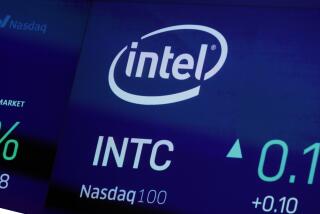Intel Drops Use of Ozone-Depleting Chemical : Environment: It is the first company to eliminate use of chlorofluorocarbons from its computer manufacturing lines.
- Share via
SANTA CLARA, Calif. — Worried about the disappearing ozone, Intel Corp. is the first company to eliminate chlorofluorocarbons from its computer manufacturing lines worldwide and hopes to be the first to cut all CFC use within a year.
The $4-billion Intel, which makes the most popular microprocessor “brains” of personal computers, planned to announce the news on Monday after stepping up its efforts two years ago to become CFC-free.
“With recent discoveries indicating that the earth’s protective ozone layer is disappearing at a faster rate than had been projected, we believe it is imperative for us to aggressively eliminate ozone-depleting chemicals from our lives,” Intel Chairman Gordon Moore said.
Chlorofluorocarbons are used widely as cooling agents in air conditioners and refrigerators and as cleaning solvents by the electronics industry. But the man-made chemicals are believed to contribute to the destruction of the ozone layer that protects the earth’s surface from the sun’s ultraviolet rays. That radiation is the type that causes sunburn and skin cancer.
Several other large electronics companies, including International Business Machines Corp., American Telephone & Telegraph Co., Digital Equipment Corp., Hewlett-Packard Co. and General Electric Co., are working to eliminate CFC use by the early 1990s, with most citing 1994 targets.
But Intel set the most ambitious target--the end of 1992--when use of the non-toxic and non-flammable CFCs is set to also stop in its computer chip making and component assembly and testing lines, mostly in Malaysia and the Philippines. Santa Clara-based Intel also has manufacturing plants in California, Oregon, Arizona, New Mexico, Ireland, Israel and Puerto Rico.
Jerry Dodson, who manages the $30-million Parnassus Fund in San Francisco that picks companies based on their good environmental record, said Intel is moving much faster than other electronic firms to cut CFC use.
“For a major company like Intel, this is quite a substantial accomplishment if they hit their 1992 target. I’m impressed,” Dodson said.
Scientists have worried since the early 1970s that the ozone is thinning greatly, particularly over the South Pole. The United States in 1978 outlawed CFCs in aerosol cans in the first move to stop use of the chemicals.
Under a 1987 international agreement, CFCs are to be phased out of production in developed countries by century’s end and globally by 2010.
In 1989, Intel used about 600,000 pounds of CFCs worldwide, according to Terry McManus, the company’s manager of corporate environmental health and safety. Use was about the same in 1990, but will drop to about 300,000 pounds this year, he said, with computer lines accounting for one-third of that.
It took three years to convert Intel’s computer factories in Oregon, Puerto Rico and Ireland. Intel switched solder paste on computer boards so water instead of CFCs can be used for cleaning. In the final assembly stage, Intel now uses a flux for soldering that doesn’t require cleaning by CFCs.
“This has actually resulted in a cost savings,” said McManus.
More to Read
Inside the business of entertainment
The Wide Shot brings you news, analysis and insights on everything from streaming wars to production — and what it all means for the future.
You may occasionally receive promotional content from the Los Angeles Times.










